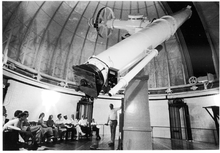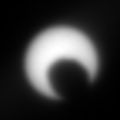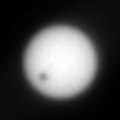火星的卫星
火星目前已知拥有2颗卫星,分别是火卫一与火卫二[1],都是火星从小行星带中捕获的天体[2]。这2颗卫星都是在1877年由美国天文学家阿萨夫·霍尔所发现的[3],后来分别以希腊神话神祇福波斯及得摩斯,它们都是战神阿瑞斯之子。除了上述两颗卫星外,火星可能还有直径小于50-100米的卫星,以及一个位于火卫一与火卫二之间的行星环。但是,上述天体还没有被发现。[4]
历史
[编辑]

美国天文学家阿萨夫·霍尔在1877年经过长期的研究后确认火卫一与火卫二的存在,虽然在这之前已经有天文学家猜测火星卫星的存在。
早期的推测
[编辑]天文学家长久以来就推测过火星卫星的是确实存在的,德国天文学家约翰内斯·开普勒甚至曾经成功预测火卫的数目,虽然根据的是错误的逻辑推论:他认为木星拥有4颗卫星,而地球则有1颗,所以火星应该有2颗卫星存在[5]。
也许是受到开普勒的启发,乔纳森·斯威夫特的著名讽刺文学作品《格理弗游记》在第3章拉普达之旅中就提出火星拥有2颗卫星的想法,认为拉普达人已经发现2颗卫星环绕火星,距离3倍与5倍火星直径,公转周期为10及21.5个小时。实际上火卫一与火卫二距离火星为1.4倍与3.5倍火星直径,公转周期为7.6及30.3个小时,与小说所描述的并不会相差很多[5][6]。法国文学家伏尔泰1750年创作的短篇故事《微型巨人》(Micromégas)描述火星人造访地球,并提到火星拥有2颗卫星[7],所以伏尔泰很可能受到斯威夫特的影响。[8][9]在火星卫星被确认之后,2个位于火卫二的坑洞被命名为斯威夫特及伏尔泰。
发现
[编辑]阿萨夫·霍尔分别在1877年8月12日协调世界时07:48及8月18日格林尼治标准时间09:14(这里使用1925年之前的天文惯例,分别相当于华盛顿标准时间8月11日14:40及8月17日16:06[10][11][12])发现火卫二与火卫一,当时他正在华盛顿特区美国海军天文台使用望远镜来搜寻火星卫星,因为他在8月10日曾经隐约观测到它们,不过受到坏天气的干扰。[13]
在伊顿公学亨利·乔治·马丹的建议下,火卫一与火卫二原本被拼成Phobus及Deimus,是根据古希腊叙事史诗《伊里亚德》第15章而来的[14]。
用于发现的望远镜是位于吉博特姆的一支口径为26英寸(66厘米)的折射望远镜。[15]于1893年,折射望远镜的镜头获重新安装,被放在一个新的圆屋下,并一直被天文学家所使用,直到21世纪。[16]

近来的探测活动
[编辑]天文学家已经借由许多探测器研究过这2颗火星卫星。斯格特·谢柏德(Scott S. Sheppard)及大卫·朱维特(David C. Jewitt)在最近对于这些不规则卫星的希尔球进行研究。这次研究范围几乎涵盖希尔球全部的地区,不过火星散发出的零散光芒则影响火卫一及火卫二所在区域的一部分。目前天文学家并未发现任何视星等达到23.5等的新卫星,它的在反射率0.07的情况下半径为0.09公里[17]。
特性
[编辑]
火星的卫星是太阳系中最小的卫星之一。火卫一稍大于火卫二,并且仅在火星地表的6,000公里(3,700英里)上空公转。至今还没有任何卫星的轨道比火卫一要接近行星的地表。[18]
如果观测者站在靠近火星赤道的地表上观测夜空,他将会看见火卫一的盘面可以达到满月时的3分之1。它角直径在升起时为8',而在天顶时可以达到12'。如果观测者距离赤道越远,火卫一将会逐渐缩小,从火星的冰帽极地是无法看见它的,因为它终年位于地平线下方。而火卫二看起来更像是一颗行星或明亮的恒星,只比地球上看见的金星稍微大一点而已,角直径约2'。而太阳在火星夜空的角直径为21'。虽然火星上不会出现日全食,因为卫星太小而且距离过远无法完全遮掩太阳。不过火卫一的月全食则是相当频繁,几乎每天晚上都会发生[19]。
火卫一及火卫二的运动与月球的运动非常不同。移动快速的火卫一从西方升起,东方落下,并且在11个小时后再度上升。而刚好位于同步轨道外侧的火卫二,则会以非常缓慢的速度从东边升起。虽然火卫二的公转周期超过30小时,但是它仍然会花费2.7天的时间才在西边落下。[18]
火卫一及火卫二都遭到潮汐锁定,所以它们总是以同一个面朝着火星。因为火卫一移动的速度大于火星的自转速度,所以它们之间的潮汐力正逐渐稳定地缩小公转轨道,每100年将火卫一拉近火星1.8米[18]。这意味着火卫一将会在50万年内越过洛希极限,遭到潮汐力的撕裂[20]。几个火星表面的环形坑洞显示过去可能曾经有其他小型卫星已经经历这样的过程,并导致火星表面的风貌完全改观[21]。而火卫二的距离够远,所以它与火星之间的距离逐渐缓慢的增加[22],与月球一样。
火星环
[编辑]火星的两个卫星一直被认为可能产生一个环绕火星的环系统,由卫星受小陨星撞击后飞溅的细小岩屑组成,稀薄黯淡不易观察。经模拟显示两卫星会各产生一个环,这环并非平面,而是呈环体(toroid),且形状会受太阳风影响而变形。1989年火卫一2号横越火卫一轨道时、观测到等离子与磁场异常的“火卫一事件”(Phobos events)常被拿来探究环的存在与否。[23][24][25][26]
卫星的来源
[编辑]

关于火星卫星的来源,至今仍然存在争议。[27]火卫一和火卫二的很多特质均与碳质C-型小行星相似,这些特质包括它们的电磁波谱、反照率和密度。[28]基于它们的相似性,其中一种说法指出火星两个卫星均来自主小行星带。[6][29]这两颗卫星均拥有近圆形的轨道,几乎等于火星的天球赤道,并因此需要透过潮汐圆化才能让原本并不圆的轨道变得那么圆。潮汐圆化是透过大气阻力和潮汐力才能进行的[30],但现在仍然不清楚火卫二成为火星卫星的时间是不是足以让潮汐圆化将其轨道变圆。[27]另外,捕获卫星也需要耗散一定的能量,而当前火星的大气太薄,薄到不足以透过大气阻力捕捉火卫一大小的天体。[27]为此,杰弗里·兰迪斯指出,火卫一和火卫二可能是双小行星系统,所以火星能够捕获它们。[29]
火卫一可能是太阳系第二代形成的卫星,因为它是在火星形成后才成为火星的卫星,而非伴随着火星形成。[31]
另一种说法则指出火星本身有很多火卫一和火卫二大小的天体,而这些天体可能是火星与微行星撞击后产生的。[32][33] 火卫一内部的孔隙率很高(根据火卫一的密度:1.88 g/cm3,火卫一内部可能有约25%至35%体积是空洞的),与小行星的特质不一致。[34]天文学家透过热红外观察火卫一,发现其成分主要为在火星上常见的层状硅酸盐。火卫一的光谱也与所有类别的球粒陨石相异,显示火卫一并非小行星。[35]此说法与解释月球成因的大碰撞说一致。[36]
数据
[编辑]| 排序 | 编号及名称 | 图像 | 直径(公里) | 质量 (kg) |
半长轴(公里) | 公转周期‡ (h) | 相对火星地表 的公转周期 | |
|---|---|---|---|---|---|---|---|---|
| Mars I | 火卫一 | 英文名称:Phobos [ˈfoʊbəs] |
22.2 km (27×21.6×18.8) | 1.08×1016 | 9 377 km | 7.66 | 11.12 h (0.463 d) | |
| Mars II | 火卫二 | 英文名称:Deimos [ˈdaɪməs] |
 |
12.6 km (10×12×16) | 2×1015 | 23 460 km | 30.35 | 131 h (5.44 d) |
图集
[编辑]-
火卫二凌日。火卫二的角直径约为2'。
-
精神号于晚上所拍的两个卫星,背景为人马座。照片亮度已增强。
-
火星卫星轨道
参见
[编辑]参考文献
[编辑]- ^ NASA - Under the Moons of Mars. Nasa.gov. [28 February 2013]. (原始内容存档于2014-03-29).
- ^ John P. Millis. Mars Moon Mystery. [2013-11-01]. (原始内容存档于2018-12-26).
- ^ The Planet Mars: A History of Observation and Discovery. Chapter 5: 1877. University of Arizona Press. Uapress.arizona.edu. [2013-02-28]. (原始内容存档于2017-11-03).
- ^ M. Adler, et al. – Use of MRO Optical Navigation Camera .. (2012) (页面存档备份,存于互联网档案馆). (PDF) . Retrieved on 16 February 2013.
- ^ 5.0 5.1 MathPages - Galileo's Anagrams and the Moons of Mars (页面存档备份,存于互联网档案馆).
- ^ 6.0 6.1 Close Inspection for Phobos. [2013-11-01]. (原始内容存档于2012-01-14).
- ^ V. G. Perminov - The Difficult Road to Mars (1999) - NASA (PDF). [2013-11-01]. (原始内容 (PDF)存档于2006-08-05).
- ^ William Sheehan, The Planet Mars: A History of Observation and Discovery (页面存档备份,存于互联网档案馆)
- ^ 伏尔泰解释,因为火星离太阳比地球更远,所以它能颗卫星 (Patrick Moore, 2000, The Wandering Astronomer)
- ^ Notes: The Satellites of Mars. The Observatory, Vol. 1, No. 6: 181–185. September 20, 1877 [September 12, 2006]. (原始内容存档于2019-05-19).
- ^ Hall, A. Observations of the Satellites of Mars. Astronomische Nachrichten, Vol. 91, No. 2161: 11/12–13/14. October 17, 1877, signed September 21, 1877 [September 12, 2006]. (原始内容存档于2019-05-20).
- ^ Morley, T. A.; A Catalogue of Ground-Based Astrometric Observations of the Martian Satellites, 1877-1982 (页面存档备份,存于互联网档案馆), Astronomy and Astrophysics Supplement Series (ISSN 0365-0138), Vol. 77, No. 2 (February 1989), pp. 209–226 (Table II, p. 220: first observation of Phobos on 1877-08-18.38498)
- ^ The Discovery of the Satellites of Mars. Monthly Notices of the Royal Astronomical Society, Vol. 38, No. 4: 205–209. 8 February 1878 [12 September 2006]. (原始内容存档于2012-07-16).
- ^ Hall, A. Names of the Satellites of Mars. Astronomische Nachrichten, Vol. 92, No. 2187: 47–48. March 14, 1878, signed February 7, 1878 [September 12, 2006]. (原始内容存档于2011-11-15).
- ^ Naval Observatory 26-inch Refractor. [2013-11-01]. (原始内容存档于2013-10-18).
- ^ The 26-inch "Great Equatorial" Refractor. [2013-11-01]. (原始内容存档于2012-10-08).
- ^ Astron. J., 128, 2542-2546 (2004). [2010-05-08]. (原始内容存档于2017-02-14).
- ^ 18.0 18.1 18.2 Solar System Exploration: Planets: Mars: Moons. NASA. [2013-11-01]. (原始内容存档于2013-11-03).
- ^ Moon Shadows: "Somewhere near the martian equator, Phobos eclipses the sun nearly every day.". [2010-05-08]. (原始内容存档于2021-02-20).
- ^ In 100 million years or so Phobos will likely be shattered by stress caused by the relentless tidal forces, the debris forming a decaying ring around Mars.. [2010-05-08]. (原始内容存档于2010-05-04).
- ^ New Map Provides More Evidence Mars Once Like Earth: "… the new map shows evidence of features, transform faults, that are a "tell-tale" of plate tectonics on Earth.". [2010-05-08]. (原始内容存档于2012-09-14).
- ^ Sahife 6: "Deimos orbits far enough away from Mars that it is being slowly pushed farther and farther away from the planet." (PDF). [2010-05-08]. (原始内容 (PDF)存档于2011-06-17).
- ^ Hamilton, Douglas P., The Asymmetric Time-Variable Rings of Mars (PDF), Icarus, 1996, 119 (1): 153–172 [2010-04-04], doi:10.1006/icar.1996.0008, (原始内容存档 (PDF)于2008-05-16)
- ^ Baumgärtel, Klaus; Sauer, Konrad; Bogdanov, Alexander; Dubinin, Eduard; Dougherty, Michele, "Phobos events": signatures of solar wind dust interaction, Planetary and Space Science, 1996, 44 (6): 589–601, doi:10.1016/0032-0633(96)00005-0
- ^ Krivov, Alexander V.; Hamilton, Douglas P., Martian Dust Belts: Waiting for Discovery (PDF), Icarus, 1997, 128 (2): 335–353 [2010-04-02], doi:10.1006/icar.1997.5753, (原始内容存档 (PDF)于2008-05-16)
- ^ The Rings of Mars: Awaiting Discovery? (页面存档备份,存于互联网档案馆) Jared R. Espley1, Claudia Knez2, Doug P. Hamilton2,Solar System Exploration Division, Code 695.0, Goddard Space Flight Center, Greenbelt, MD 20771 (Jared.Espley@gsfc.nasa.gov), 2Astronomy Dept., University of Maryland – College Park, College Park, MD 20740.
- ^ 27.0 27.1 27.2 Burns, J. A. "Contradictory Clues as to the Origin of the Martian Moons," in Mars, H. H. Kieffer et al., eds., U. Arizona Press, Tucson, 1992
- ^ New Views of Martian Moons. [2013-11-01]. (原始内容存档于2011-11-14).
- ^ 29.0 29.1 Landis, G. A. "Origin of Martian Moons from Binary Asteroid Dissociation," American Association for the Advancement of Science Annual Meeting; Boston, MA, 2001; abstract (页面存档备份,存于互联网档案馆).
- ^ Martin Pätzold and Olivier Witasse. Phobos Flyby Success. ESA. 4 March 2010 [4 March 2010]. (原始内容存档于2010-03-07).
- ^ The Moons of Mars. [2013-11-01]. (原始内容存档于2013-10-19).
- ^ Craddock, R. A.; (1994); The Origin of Phobos and Deimos, Abstracts of the 25th Annual Lunar and Planetary Science Conference, held in Houston, TX, 14-18 March 1994, p. 293
- ^ Andert, T. P.; Rosenblatt, P.; Pätzold, M.; Häusler, B.; Dehant, V.; Tyler, G. L.; Marty, J. C. Precise mass determination and the nature of Phobos. Geophysical Research Letters (American Geophysical Union). 7 May 2010, 37 (L09202): n/a [1 October 2010]. Bibcode:2010GeoRL..3709202A. doi:10.1029/2009GL041829. (原始内容存档于2010-06-26).
- ^ Giuranna, M.; Roush, T. L.; Duxbury, T.; Hogan, R. C.; Geminale, A.; Formisano. Compositional Interpretation of PFS/MEx and TES/MGS Thermal Infrared Spectra of Phobos (PDF). European Planetary Science Congress Abstracts, Vol. 5. 2010 [1 October 2010]. (原始内容存档 (PDF)于2011-05-12).
- ^ Mars Moon Phobos Likely Forged by Catastrophic Blast. Space.com web site. 27 September 2010 [1 October 2010]. (原始内容存档于2010-09-30).
外部链接
[编辑]
| ||||||||||||||||||||||||||||||
| |||||||||||||||||||||||||||||||||||||||||||
| ||||||||||||||||||||||||||||||||||||||||||||||||||||||||||||||||||||||||||||||||||||||||
Text is available under the CC BY-SA 4.0 license; additional terms may apply.
Images, videos and audio are available under their respective licenses.










